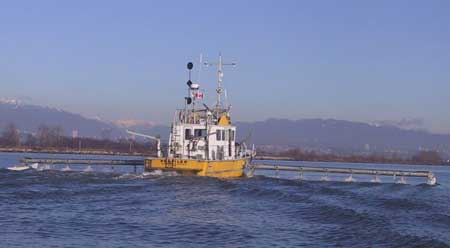Using GPS Technology
to Map The Mighty Fraser — Improving data collection along an economic artery
Speed and accuracy are the hallmarks of a new Global Positioning System (GPS) service that PWGSC, the Greater Vancouver Regional District (GVRD) and its member municipalities have recently developed. It’s based on partnerships between four levels of government and the private sector to ensure data collection along the Fraser River is timely and accurate.
The state-of-the-art technology is called the GVRD Real-Time Kinematic GPS Service and it enables users to access live broadcast data from one of five continuously operating GPS reference stations. One of the first comprehensive satellite-based systems of its kind in Canada, the new system will improve the speed and accuracy of data collection for applications ranging from construction and legal land surveying to GIS (Geographic Information System) mapping, asset management and engineering.
For the Pacific Region, the new GPS technology enables PWGSC’s Marine Services section to improve the accuracy and speed it collects hydrographic survey data about the Fraser River on behalf of its client, the Canadian Coast Guard (CCG), Waterways Development.
 |
| The PWGSC survey vessel "MV Profiler" using the GVRD Real-Time Kinematic
GPS Service to monitor the Fraser River deep sea shipping channel. |
“The hydrographic data that we collect from our survey vessel enables us to chart the river bottom, determine water depths, and measure the currents – all vital information for monitoring the deep sea shipping channel of the Fraser River and assisting deep sea ships navigating through it,” says Gouin Barford, PWGSC’s Discipline Head for Marine Engineering in Pacific Region.
The GPS reference stations are located throughout the Lower Mainland region surrounding Vancouver and achieve in real-time, three-dimensional positioning, accurate to within a few centimetres. This means that users equipped with a GPS instrument can plot their geographic co-ordinates within an inch or more of accuracy, as long as they are within a 20-km radius of one of the reference stations.
“The new system reduces field time and processing time, as well as improves the accuracy of the data,” explains Mick Mills, Manager of the Hydrographic Survey Unit that surveys the Fraser River.
For example, during spring freshet – when the rush of fresh water from the Fraser River flowing into the ocean increases – the river becomes shallower due to the rapid build-up of sediment deposited on the river bottom. As a result, the river can become a potential hazard to navigation. With the new GPS system, the hydrographic crew can survey a 2-km stretch of channel one day and provide the information electronically to the Canadian Coast Guard the next day.
“This enables us to have paper plots in the hands of the river pilots within 48 hours of completion of the survey,” Mr. Mills notes.
In addition, the Real-Time Global Positioning System service provides benefits such as reducing expenditures on survey controls (which are points that surveyors use as a reference), and extending hydrographic surveys into areas where survey control was previously hard to establish.
“As well as improving accuracy and turn-around time, we have been able to improve our overall coverage and increase the number of monitoring surveys without increasing our budget,” explains Wayne Dutchak, Superintendent of CCG Waterways Development.
Prior to the development of this technology, municipalities throughout the Lower Mainland had to obtain geographical co-ordinates from over 13,000 survey monuments, which required regular maintenance and upkeep.
This new geo-reference service will gradually phase out many of these old survey monuments, reducing the municipal costs to maintain them and ushering in a new era of economical, real-time, data collection.
Previous
| Index
| Next
|